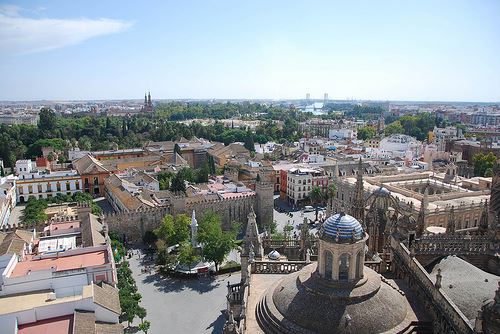
"Sevilla", South of Spain, by Werkmens, at flickr.com
.jpg)
This is the "Theatre Lope de Vega"
Situated in front of the "Parque Maria Luisa" ( Maria Luisa Park ), it has a large story: In 1929, Sevilla was preparing it self, for receiving the Latin American Exposition.And it was decided to build The Pavilion of Seviila, made up of two elements: The Casino and the Theater of the Exposition. The project was entrust to the young Architect: Vicente Traver y Tomás. And the decoration was entrust to the artists Martinez del Cid and Zaragoza.In 1927, it was put the Theater up for auction for something else than 7.000 Euros.The building work last two years.Traver used elements from the Baroque Architecture.The circular room and the portico with columns were inspired in Bernini.Also in 1929, the Catalina Bárcena´s Company was the first one who went up to the new stage, with the play: "El Corazon ciego" (The blind heart), by Gregorio Martinez Sierra.During the Exposition, all kind of shows were performed, one of the was: the premiere "Los duendes de Sevilla" (The goblins from Sevilla), a Comedy by Joaquin and Serafin Álvarez Quintero (the famous Brothers Álvarez Quintero).The October 28, it was visited by the King and Queen, Alfonso XIII and Victoria Eugenia, who could enjoy the performance of Zarzuela: "El huesped del Sevillano" (The Sevillan´s guest).But, in a shrt time, the new shows (Movies and Football) did that the Theater perform less plays and the terrace of the Casino was converted to a movie theater for summer.In 1936, it is changed its name and the new one shall be: Teatro Municipal Lope de Vega (Local Theater Lope de Vega).The Civil War and the long postwar period did that the theater was almost leaved.And, Sevilla was trowing oneself into some news private rooms.During the Civil War, The Casino was changed to a hospital and the theater sufer a fire, on the roof, which destroyed the lamp in the center and all the seats.In 1939, the roof was closed and the lamp was replaced with indirect lights.The Opera reemerged.From 1960, the theater shall get a certain importance, cause of the indepentent companies.In 1961, it happens a great flood and it affects to the pit.In 1977, the theater is transfered to the Department of Culture and it shall be named "Local Theater of Sevilla Lope de Vega".In 1985, it sufer a great reform and it will belong to the city council.In 1988, the theater was open again with a concert by the Philharmonic Orchestra from London, under the Jerzy Maksymiuk´s baton and the chords of the 7 th. symphony by Haydn.Since then, the theater became a great importance, in the culture of Seville, and, each year, a lot of performances are given (more than 180 performances) and more than 100.000 members of the audience.
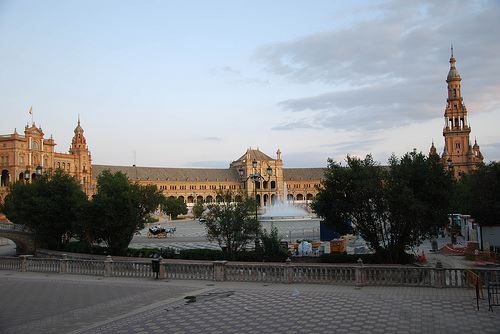
"Sevilla" (Plaza de España), South of Spain, by Werkmens, at flickr.com
Close to the theater Lope de Vega, is The Spain Square.This picture shows you a part of that square.This square is situated inside the Maria Luisa´s Park.The entrance nearest to the Park is trough the roundabout of the Cid Campeador, just in front of that monument and the old Factory of Tobacco.The Spain Square was the most significant project in the Latin Exposition in 1929.The project was made by the sevilan architect Anibal González.The construction began in 1914 and it was the most expensive and ambitious project in The Universal Exposition of 1929.In 1926, Anibal Gonzalez resigned as the Director of the Exposition and took the project Vicente Traver, who finished the doors of the enclosure and made the spring in the middle of the Square.
.JPG)
Here is a door to go out of the square.It is in a side of the square.On right of the picture and under each arch, you can see the coat, which represents to each province of Spain.It is very nice.
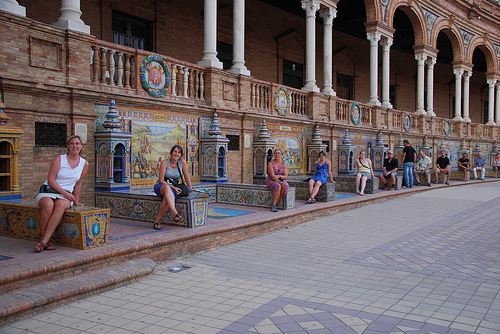
"Sevilla", South of Spain, by Werkmens, at flickr.com
In this picture, you can see the coats of some spanish provinces.
.JPG)
Here you can see two statues, in the center of the Maria Luisa Park.
.jpg)
This is the main facade of the Faculty of Law.
.JPG)
.JPG)
This is the stairs to go up to classrooms.
.JPG)
This is the main entrance to the patio of the Faculty.
.JPG)
This is another angle in the patio.
.JPG)
This is one of the doors of the Cathedral.This is the bigest Gothic Cathedral, all over the world, and the 3 th. Catholic Temple, after San Pedro del Vaticano, at Rome, and San Pablo (St. Paul) in London.It was declared World Heritage, by UNESCO, in 1987.The Metropolitan City Government has been a curator during the 7 centuries of the history of the Cathedral. For that, it keeps the Liturgy, each day, the celebration of the great feasts, like: The Corpus Chistri and the Inmaculate Conception of the Virgin Mary; and it takes care of the devotion for the Virgen de los Reyes (Virgin of the Reyes), permanently.Las 2008, the oldest plan of the Cathedral, in the Monasterio de Bidaurreta, Oñate (Guipuzcoa).The Cathedral started to be built in 1401.Among 1172 and 1248, it had an influence Almohade.From 1248 to 1433, it had an style Mudéjar: the building was a spoiled mosque and They wanted to convert it in a Christian Cathedral.Then, From 1433 to 1528, it was a Gothic Temple. From 1528 to 1593, it had an influence Renacentista and, for example, the architect Hernan Ruiz, increased the tower.From 1618 to 1758, it took an influence from the Baroque.In that period, was built the parish church of the Tabernacle.From 1758 to 1823, it had an influence Academica (Academic), cause of the imposition from the academy from Madrid.From 1825 to 1928, the influence was Neogotica (NewGothic) and, in this period, happened the repair of some gothic works and the termination of some parts no finished in earlier times, observeing the first one gothic plan.
.JPG)
.JPG)
This is the main facade of the Cathedral, with the new streetcar in Sevilla (it only run around the Cathedral and the center of Sevilla, only about 500 meters).

This is another door of the Cathedral.
.jpg)
This is another side of the Cathedral with the Giralda behind it.

This is "La Giralda".This one practices as the tower and the bell tower of the Cathedral.The Giralda has 13,61 meters of side and 104,06 meters high.It was built, based on the alminar of the Mosque Kutubia in Marrakech (Marocco), although the top and the bell tower has a Renaissance influence from Europe.
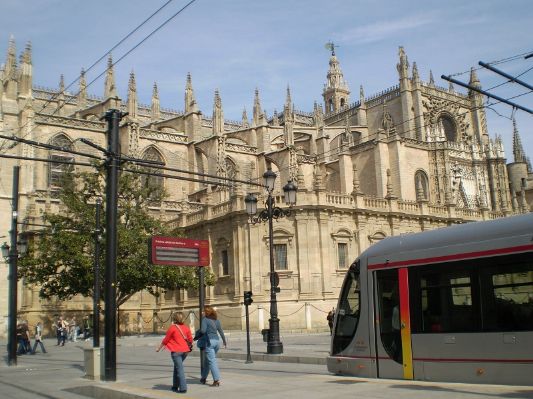
Here you can see the whole Cathedral and the streetcar arriving to its next stop, beside the Cathedral.
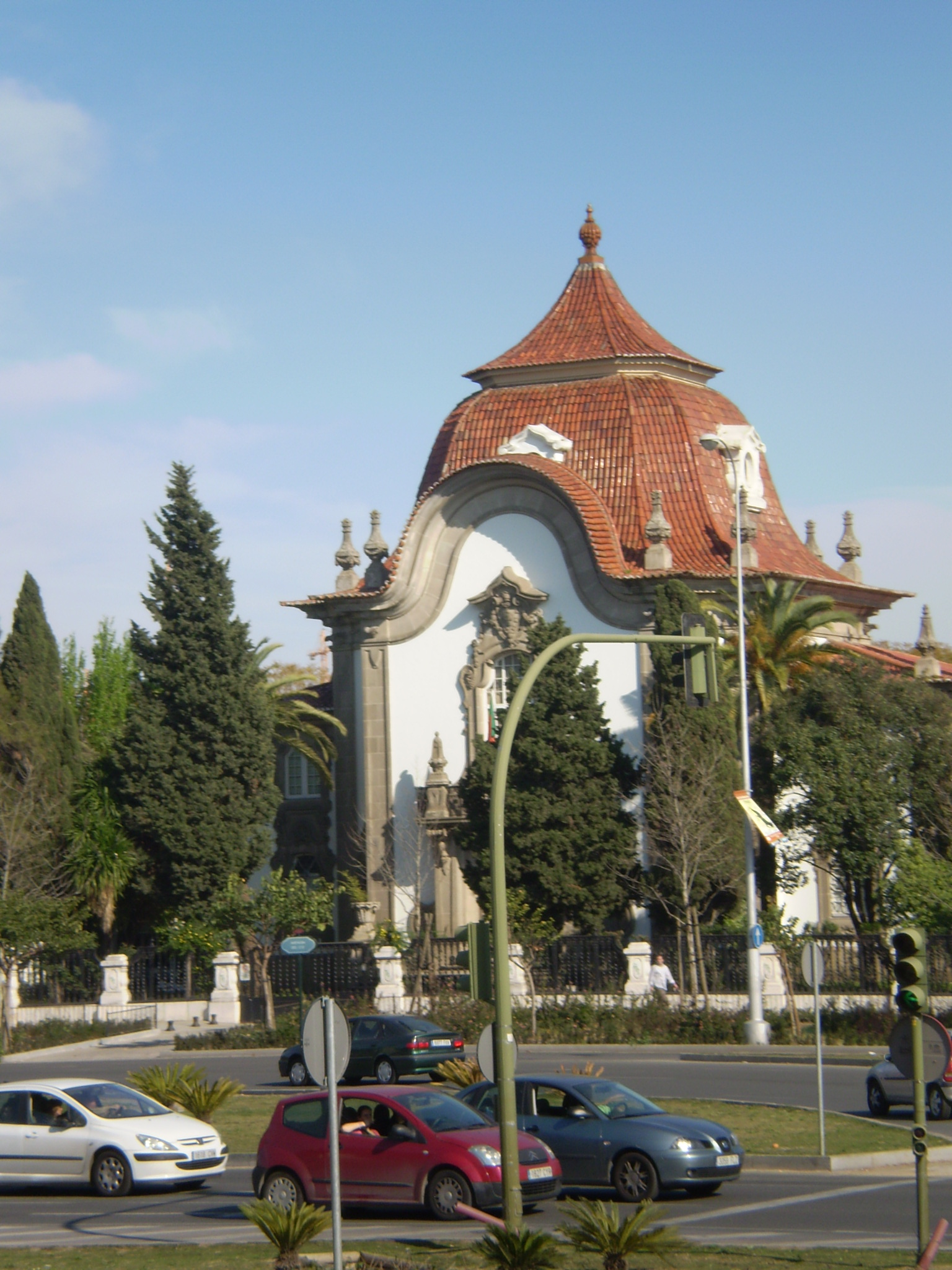
That is the Honorary Consulated from Portugal.It is situated close to the Parque Maria Luisa.

Going out of the center of Sevilla, and in one of the banks of the river Guadalquivir, you can see this famous tower (La Torre del Oro).La Torre del Oro es una Torre "albarrana": a tower, which belongs to a fortify enclosure, comunicated with it, but without wall, but probably with a little arch, which can be destroyed, if it falls in the enemy´s hands.In Spain, there are some Torres (towers) albarranas: La Torre del Oro; la de la Malmuerta, in Córdoba; la Torre de Espantaperros, in Badajoz; some built by Juan Manuel, in the Castle of Escalona del Alberche.The most concentration of that kind of tower is in Talavera de la Reina.The Torre del Oro is situated in the left side of the river and close to the famous bullring of the Real Maestranza.The name Torre del Oro, in Arabic, surely was "Bury al-dehab", with regard to the golden shine, which was reflected on the river.During the restoration, in 2005, it was demostrated that this shine, which till then it was assumed to a tiling, was a mixing of mortar, lime and pressed straw.The tower consist of three parts: the first one body, dodecagonal (consist of 12 sides), was built, among 1220 and 1221, by order from the almohade Governor in Sevilla.The second body was ordered by Pedro I El Cruel, in the XIV Century.The hihgest body, cilindrico (with a cylinder as a form) and crowned with a cupola, it was built, in 1760, by the militar engineer Sebastian Vander Borcht.The Torre del Oro was declared Historical and Artistic Monument, in 1931 and it has been restored in several times.In its preservation, the work by the Spanis Army has been very important; so, actually, it houses the Naval Museum.
.JPG)
This is the famous Puerta de La Macarena (La Macarena is a very popular Virgin in Sevilla).Behind it is the Basilica of the Esperanza Macarena.This is an typical example, in which the most of the islamic architectonic elements have been removed and they have been replaced with another elements with classical style among Centuries XVII and XVIII or all reconstructed, among 1723 and 1795.This is the door trough which more Kings and Queens went past (for example: Felipe II, Fernando III and Carlos I de España.

This is the Consulated of Colombia and it is situated out of the center of Sevilla.
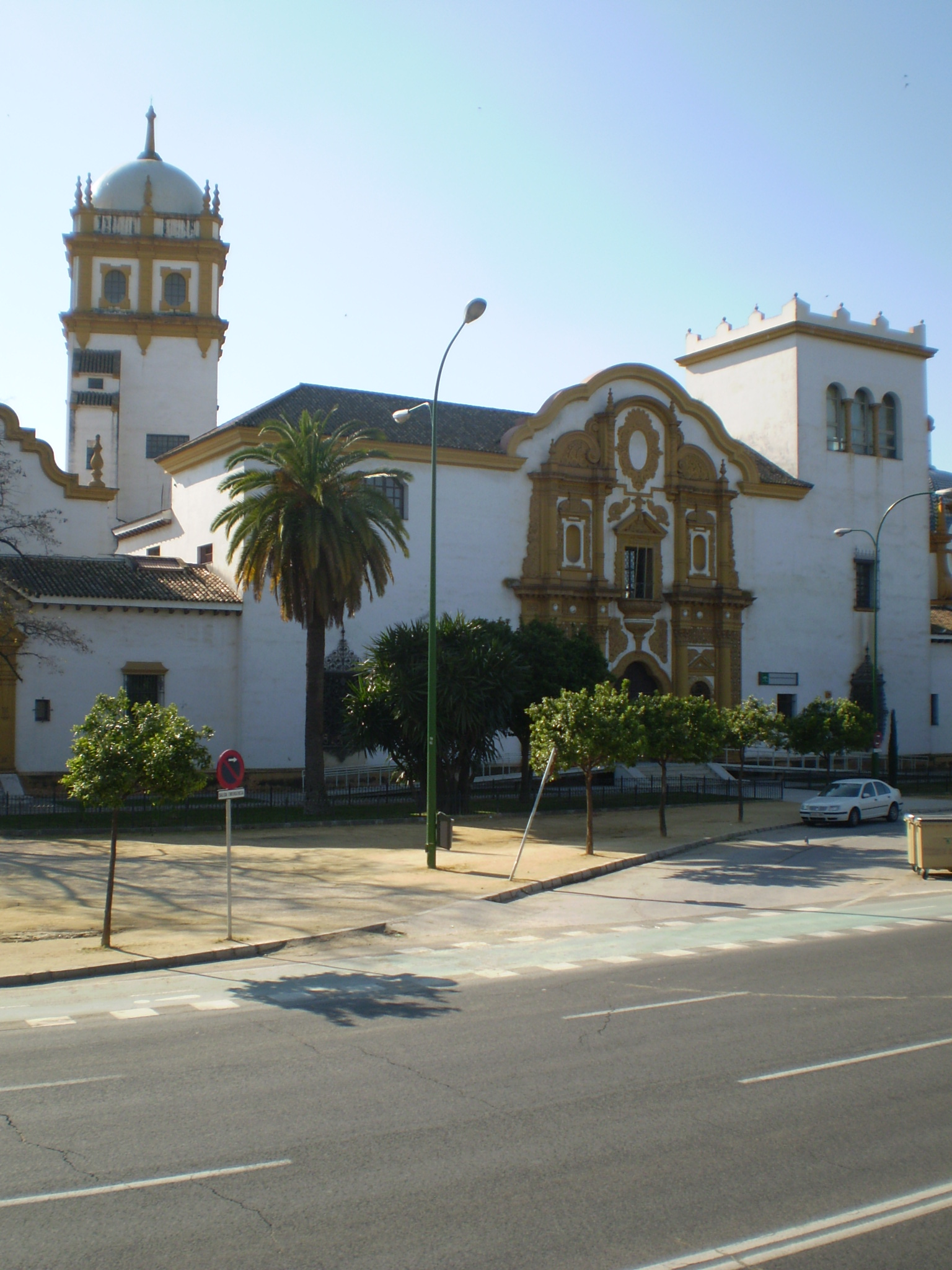
This is the Consulated of Argentina and also it is situated out of the center of Sevilla.
.JPG)
This is another view of Plaza de España, when you come back from the Puerta de la Macarena.
.JPG)
This is the famous bullring "La Maestranza" --well, it real name is: "Real Maestranza de Caballería de Sevilla"--.Its owner is a Corporation of the Nobility, situated in Sevilla, made up by gentlemen from old families of noble lineage; they take a lot of activities with charity and social character, which promotes the equestrian art and support to the bullfighting.The cultural and artistic sponsor is another dedication.
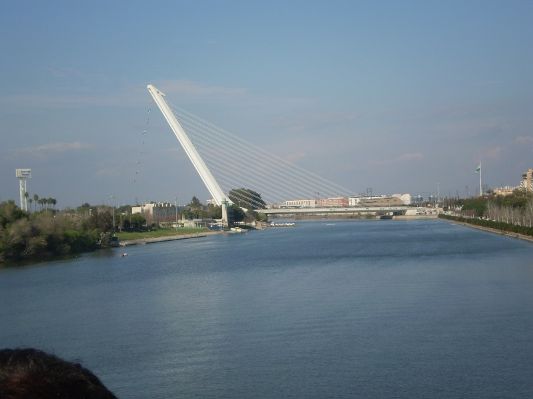
That is the bridge named: "Puente del Centenario" (The bridge of the Centenary), because it lets you crossing the river (Guadalquivir) to the World Fair (in the named "Isla Mágica"), in 1982 (at the left side of this picture).
.JPG)
Those are the chimneys of the kilns, where are made the famous dinner service from La Cartuja --usually, you can buy a pink or blue or black dinner service--.The prices are: A dinner service for 43 persons (308 Euros: the cheaper type); for 57 persons (396: the cheaper type).
.JPG)
.JPG)
Going back to the Bus-stop, beside the river Guadalquivir, I could see the majestic Golden Tower (Torre del Oro).
Kind regards,
Luis.
